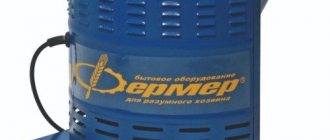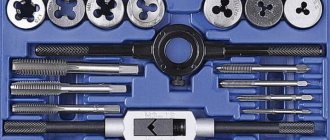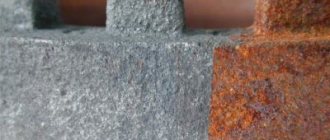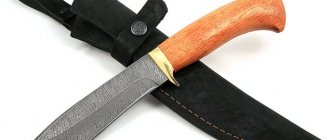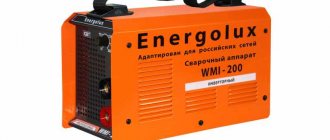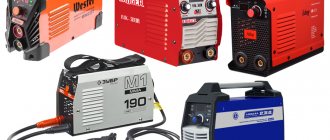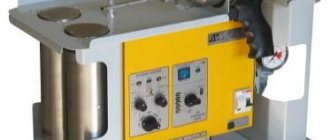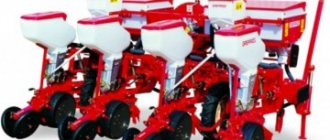| Place | Name | Characteristics in the rating |
| TOP 10 best plasma cutters |
| 1 | Cebora Power Plasma Sound PC 70/T 334 | The best choice |
| 2 | Svarog REAL CUT 45 L207 93557 | Long service life |
| 3 | FoxWeld Plasma 43 | The most advanced protection systems |
| 4 | Fubag PLASMA 40 | The best compact plasma cutter |
| 5 | RESANTA IPR-40K | Convenient device for home use |
| 6 | Cedar CUT-40 | Minimal metal deformation when cutting |
| 7 | TRITON CUT 70 PN | The best price for a professional device |
| 8 | BRIMA CUT-40 | Attractive price |
| 9 | RUSELKOM CUT 40 (KR) | Simple plasma cutter for home |
| 10 | MICROPLASMA 50 | The most precise tool |
Top 10 inexpensive plasma cutters
Expensive industrial-type plasma cutters can cost hundreds of thousands of rubles. However, the market offers a wide range of devices from the middle and low price categories.
TSS Pro Cut-40
The inverter plasma cutter operates on a 220 V network and produces a maximum current of 40 A. The model’s switching frequency is 60%, and the largest cut thickness is the standard 12 mm. Works with any metals and alloys, but requires connecting a separate compressor.
The cost of a plasma cutter starts from 18,000 rubles
Fubag Plasma 30 LV
A household appliance with a modest consumption of 3.6 kW operates from a regular network and produces a maximum of 30 A during operation. The frequency of switching on is low - 32%; the plasma cutter often needs rest. It consumes 115 liters of gas per minute and has a cutting thickness of up to 10 mm.
The small capabilities of the Fubag model 30 LV plasma cutter pay off at an affordable price - only 4,500 rubles
Ruselcom Cut 40
One of the best plasma cutters for the home offers a cutting current of up to 35 A and can handle workpieces up to 12 mm thick. The unit does not have a built-in compressor, so you will need to purchase an external source for it. The model is air-cooled, but the efficiency is at least 60%, which is why the unit is highly popular.
You can buy a Ruselcom cutter for 18,700 rubles
Bars Profi Cut 47 D
A household plasma cutter is capable of delivering from 20 to 40 A of current when welding. Supports connection to a 220 V network, copes with metals up to 12 mm. It does not warp or deform sheets during operation, and makes cuts accurately and quickly.
Bars Profi without a built-in compressor costs about 17,000 rubles
FoxWeld Plasma 43
A plasma cutter with a high efficiency of 85% is durable and resistant to wear - the consumables and energy carriers of the device do not fail for a long time. The device is equipped with automatic purge and the possibility of electronic adjustment. It has compact dimensions and a relatively light weight of 8.5 kg.
The price of FoxWeld Plasma 43 is average, approximately 20,000 rubles
Resanta IPR-40K
The Latvian-made plasma cutter is equipped with a manual ignition system, supports a current of up to 40 A, and at maximum load demonstrates an operating duration of 35%. Copes with 12 mm steel and 6 m aluminum, runs on household power.
You can buy Resanta IPR-40K from 21,000 rubles
Kedr Cut-40
An inexpensive professional cutter consumes as much as 6.6 kW during operation, so it is most often used in industrial settings. It has a maximum current of 40 A and a switching frequency of 60%, saws metal up to 12 mm.
You can buy a Kedr plasma cutter for 22,000 rubles
FoxWeld Saggio Plasma 40
Another plasma cutter from FoxWeld supports a standard 12mm section thickness and exhibits a firing cycle of 35%. Capable of delivering current from 15 to 40 A, it has a high class of protection and insulation. Requires the purchase of an external compressor, and the air supply should not be lower than 110 liters.
Saggio Plasma 40 from FoxWeld costs about 15,000
Resanta IPR-25
An inexpensive plasma device suitable for home use. The maximum current of the device is only 25 A, while the switching frequency is quite high - 60%. Supports a non-contact ignition system, operates from a 220 V network and does not create overloads for the electrical system.
You can buy the IPR-25 plasma cutter model from Resant for only 7,000 rubles
FoxWeld Plasma 33
FoxWeld's inexpensive air plasma machine is used for cutting steel, aluminum alloys and other metals. It has an efficiency of 85%, supports a current of 15-30 A, and makes cuts up to 8 mm. The ignition system in the device is contact; to work with a plasma cutter, it is recommended to buy a compressor with a capacity of at least 170 liters per minute. The device is supplied with a hose, a grounding cable and a reducer-dryer unit for air preparation.
On average, the price of FoxWeld Plasma 33 starts from 13,000 rubles
Inverter plasma cutting: pros and cons
Like any other welding machine, a plasma inverter has its advantages and disadvantages in comparison with devices for gas, electric arc, electroslag, laser and other types of welding.
Advantages It has a high efficiency of heating the metal, in contrast to gas welding, during which it is almost impossible to achieve this. It can weld the thickest parts (this property, except for plasma, is provided only by an electroslag welding machine, while all other devices have limitations in volume parts they work with) Capable of working with all types of metals and even non-metallic substances, which no other welding machine can guarantee. Small in size, reliable and extremely easy to use.
Disadvantages It is highly expensive, unlike a device for gas welding, the purchase of which will not hurt the wallet of the average user. It is characterized by infrared and ultraviolet radiation, as well as saturation of the air with harmful ions, as opposed to absolutely safe laser welding. During operation, it emits harmful metal vapors, in contrast cold welding unit
Types of plasma cutters
Despite the large number of models on the market, there are several ways to divide them into types.
- By type of cutting: manual and automatic. The first ones are suitable for the garage and take up little space. The scope of application of the latter is wider. Depending on the technical characteristics, they can be used in small workshops or large factories. Manufacturers often allow you to automate the operation of the device using a CNC machine.
Manual plasma cutter, automated using a CNC machine - By gas type. Manufacturers offer devices that operate on compressed air, argon, oxygen, nitrogen or various mixtures.
- According to the method of arc ignition: contact, pneumatic and high-frequency. The contact method is used in household models. Pneumatic ones are used most often as this type is easy to use and can also save gas.
- By cooling method: air and liquid. Air cooling is used on semi-professional models. The cooling rate is much lower than when using liquid.
These are the main ways to separate plasma cutters.
What is the device
Device structure
The plasma cutter is a rather complex apparatus, consisting of several main components:
Plasma cutter elements
Next, we will consider in detail the device of the plasma cutter.
Plasma torch
This element is a plasma cutter, in fact, the main element of the device that produces plasma. The plasma torch is connected to other elements of the device using a cable and hose through which air and electric current are supplied.
It must be said that there are two types of cutters:
Direct action. An arc occurs between the metal workpiece and the cutter. These are the plasma torches that are used to work with metal;
Diagram of the direct action plasma torch
- Indirect. The arc discharge occurs inside the plasma torch itself. This allows the machine to be used for cutting non-metallic materials. The plasma torch contains two main elements:
- Nozzle. This part forms a plasma jet. The metal cutting speed, cut size and cooling intensity depend on its diameter and length. As a rule, the nozzle diameter does not exceed 3 millimeters, and the length is 9-12 millimeters. The longer the length, the better the quality of the cut, but the less durability of the nozzle itself. Therefore, the best option is when the length of the nozzle is one and a half times greater than its width;
Diagram of the nozzle and electrode
Electrode. A metal rod, usually made of hafnium. The electrode provides excitation of the electric arc for air plasma cutting.
Power supply
The job of the power source is to supply current to the plasmatron. There are two types of power supplies:
Transformer. They are weighty and consume a lot of energy, but they are less sensitive to temperature changes. In addition, the thickness of the workpiece that the machine is capable of cutting can reach 40-50 mm;
The inverter has compact dimensions
Inverters. Lighter, more compact and energy efficient. In addition, inverters provide a more stable arc. The disadvantages are that they can be used for cutting sheets no more than 30 millimeters thick.
The compressor provides the device with compressed air at constant pressure
Compressor
To operate a plasma cutter, gas is required, which ensures the formation of plasma and is responsible for cooling the plasma torch. Therefore, a compressor is used to supply gas to the nozzle.
In devices with a current not exceeding 200 A, air is used as a gas. Such a machine can cut workpieces up to 50 millimeters thick.
An industrial machine works with other gases such as argon, helium, nitrogen, hydrogen, etc.
A cable-hose package connects individual units into a single device
Cable-hose package
As I said above, this element combines the individual components of the device into a plasma cutter, i.e. The hose supplies gas to the nozzle, and the cable supplies current to the electrode.
Useful tips for purchasing and caring
Features of choosing and caring for the cutter:
If you have a choice, always choose those models that have a Euro connector. In these models there will be no problems with connecting or extending the cable-hose package and other elements to each other. We don’t skimp on consumables. Only high-quality ones will work for a perfect cut and durability of the cutter. The nozzle and cathode wear out the fastest, therefore, the condition of these elements must be monitored with special care. A cutter is a cutter, so the safety rules in this case are reinforced concrete. You need to have a protective shield and special glasses. Keep in mind that plasma cutting is a splatter of molten metal. Therefore, gloves and even safety shoes will not hurt you. Working at maximum power predetermines a subsequent stop in work. One of the most important technical characteristics of metal plasma cutting machines is the duration of their operation without interruption. If your house has old wiring, be sure to check how your new cutter will “make friends” with your old network
Most likely, friendship will not work out, this needs to be taken into account.
“Gorynych”
The Gorynych device is a Russian-made plasma welding and cutting machine suitable for work involving high-temperature exposure. Can be used for both metals and other categories of materials that are not subject to combustion. It is an electric arc generator of plasma formed when an electron arc is heated. The vapors of the working composition, reaching the ionization temperature, are removed by a plasma jet under pressure. The working fluid can be ethyl alcohol or water; the choice of one or another option is carried out in accordance with the tasks. The jet has a temperature of about 6000 degrees. The main elements of the device are the control unit and the plasma generator.
“Gorynych”, a plasma welding and cutting machine, receives mostly positive reviews. Many users note its high speed and versatility.
Tips and recommendations when choosing plasma cutters
There are several recommendations from experts who can help you choose the optimal model. Here's what you need to pay attention to before purchasing:
- metal thickness. The specifications indicate the maximum thickness. But you need to understand that different metals have different densities, so the data in the instructions are unified;
- The duration of operation allows you to understand how long the plasma cutter can operate without overheating. For domestic use, you can use models with an indicator of 40%, but for production you need at least 60-80%;
- the power of the device must be at least 20% higher than that required for processing a particular workpiece. This will reduce the load on the tool and increase the speed of metal processing;
- hose package length. It varies from 1.5 to 8 meters. When working with large workpieces, it is better to buy the maximum length so as not to waste time rearranging the plasma cutter.
Video - How to choose a plasma cutter
Important! It is also worth paying attention to the equipment if the budget is very limited. Devices with a built-in compressor are more expensive. But if it is not included in the kit, you will need to make an additional purchase, because without a compressor you will not be able to use a plasma cutter. The display may be a useful feature, but it does not affect the performance of the instrument.
These are the main nuances that are worth remembering when buying a plasma cutter. By choosing from the above tools, you can make a great purchase at a decent price. But new models are constantly appearing on the market, so it is important to understand what to look for when choosing. This will allow you to buy a tool that will really be needed in a particular case.
Video - How to assemble a plasma cutter with your own hands and what it consists of
Principle of operation
A plasma cutter automatically creates a stream of high-temperature air (plasma), and with its help cuts the workpiece into the required parts. The operating principle is based on the fact that ionized air is a conductor of electric current. The plasma torch creates plasma and a welding arc. They cut and carefully separate the material. Actually, these subtleties are the principle of operation of a plasma cutter. You will find basic details about each of the models in our article and in the instructions for use - they are included with each device.
Which cutter to choose
Let's start with a fact known to any welder, which also applies to plasma cutting: the higher the current, the higher the speed of the work process. There are other parameters to consider when choosing the tool for your job.
The thickness and type of metal is one of the main criteria. On the Internet you can find a lot of tabular material with the technical characteristics of plasma cutters depending on them. For example, to successfully cut a copper sheet 2 mm thick, you will need a device with a permissible current of 12 A.
An important rule is the mandatory “reserve” of current strength: buy a cutter more powerful than indicated in the tables. The fact is that the table parameters are maximum numbers; the device can only work with these values for a short time.
Scheme of operation of a plasma cutter.
The smartest choice is based on three criteria: workflow speed, cutting time and power.
- The required operating power is determined taking into account the thickness of the planned metal and its type. For example, a power of 90A will allow you to cut metal up to 30 mm thick.
- If the metal is thicker, you need to choose a cutter with a power in the range of 80 - 180A.
- The diameter of the nozzle and the choice of flow type always depends on the type of metal being cut.
- Important parameters for choosing a plasma cutter machine are also the rated primary voltage and current.
- You need to decide what type of device you need - universal or special purpose.
- Checking the adequacy of the device to the electrical network is mandatory: can it be connected to a general network or do you need a professional one with a different voltage. Simpler devices operate only at 220 or 380V; the power phases can be single- or three-phase.
- Metal cutting speed is measured in cm/min.
- Another important and indicative criterion is the ability of the cutter to work continuously for a long time, in other words, the duration of operation without interruption. If it is indicated as 50%, this means that after 5 minutes of continuous cutting the device must be turned off for 5 minutes.
Voting for the best plasma cutter
Which plasma cutter would you choose or recommend?
ESAB CUTMASTER 120
7.14 % ( 1 )
BLUEWELD Best Plasma 100
7.14 % ( 1 )
Telwin SUPERIOR PLASMA 90 HF
7.14 % ( 1 )
Grovers CUT 40 compressor
14.29 % ( 2 )
Fubag PLASMA 65 T
14.29 % ( 2 )
Svarog REAL CUT 70 (L204)
0.00 % ( 0 )
Fubag PLASMA 40
14.29 % ( 2 )
RESANTA IPR-40
7.14 % ( 1 )
Aurora AIRHOLD 42
14.29 % ( 2 )
Operating principle
What is plasma
We’ve figured out the devices of the device, now let’s look at how a plasma cutting machine works, and what the word “plasma” actually means. So, plasma is air or other gas heated to a high temperature and in an ionized state. The heating temperature can reach 30,000 degrees.
The diagram shows the principle of plasma cutting
The operating principle of the device is as follows:
- When the ignition button is pressed, high frequency currents are supplied to the electrode;
- A pilot arc is formed between the nozzle and the electrode, the temperature of which reaches 8000 degrees;
- Then compressed air is supplied to the nozzle;
- The air breaks through the arc, as a result of which it heats up and increases in volume a hundred times. In this case, it is ionized, and the air acquires conductive properties;
- When the plasma comes into contact with the workpiece, a cutting arc is formed, and the pilot arc goes out. As a result, the metal is easily cut, and the air is blown away from the cutting line.
You can make a plasma cutting machine yourself. For this, they usually use a welding machine inverter, but you can make the device “from scratch” using the diagrams available on the Internet.
A homemade plasma cutter will cost you several times cheaper than a branded one
Fubag plasma 40 air
This tool offers the most common cutting method thanks to the built-in compressor.
The cutter offers fairly fast processing of carbon and stainless steel, various aluminum alloys, etc.
The equipment includes a copper grounding cable 4 meters long, a protective cap and a plasma torch.
Fubag plasma 40 air Advantages:
- Built-in Air compressor, which ensures the mobility of the plasma cutter;
- High-quality metal cutting;
- Non-contact arc ignition;
- Accidental overvoltage protection system.
Flaws:
Small cutting thickness.
Specifications
| Options | Characteristics |
| Mains voltage | 220 V |
| Cutting current | 20-40 A |
| Cutting thickness | 15 mm |
| Load power | 5 kW |
| Dimensions | 525x220x405 |
| Weight | 19 kg |
| Electricity consumption | 16 A |
| Network frequency | 50 Hz |
| Standard cutting thickness | 8 mm |
| Price | 76,000 rubles |
